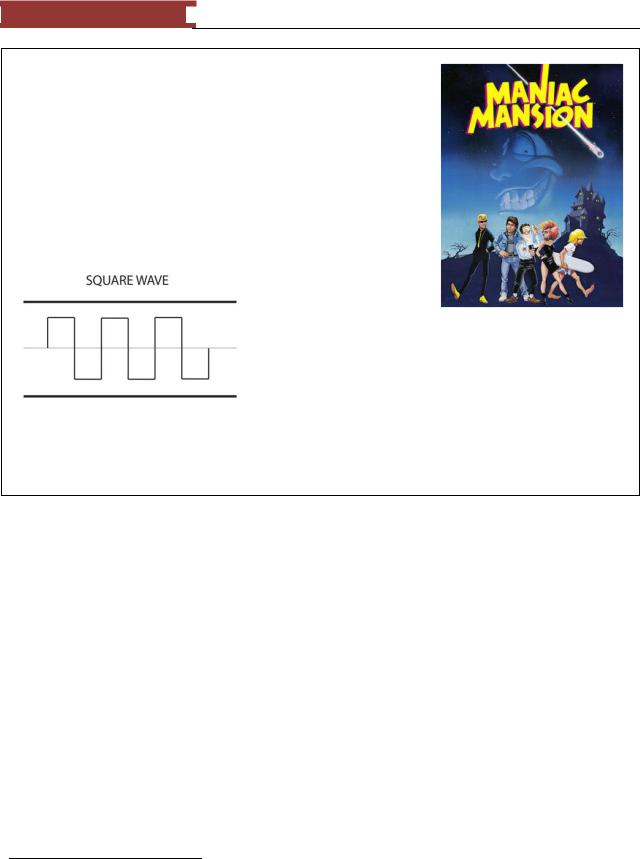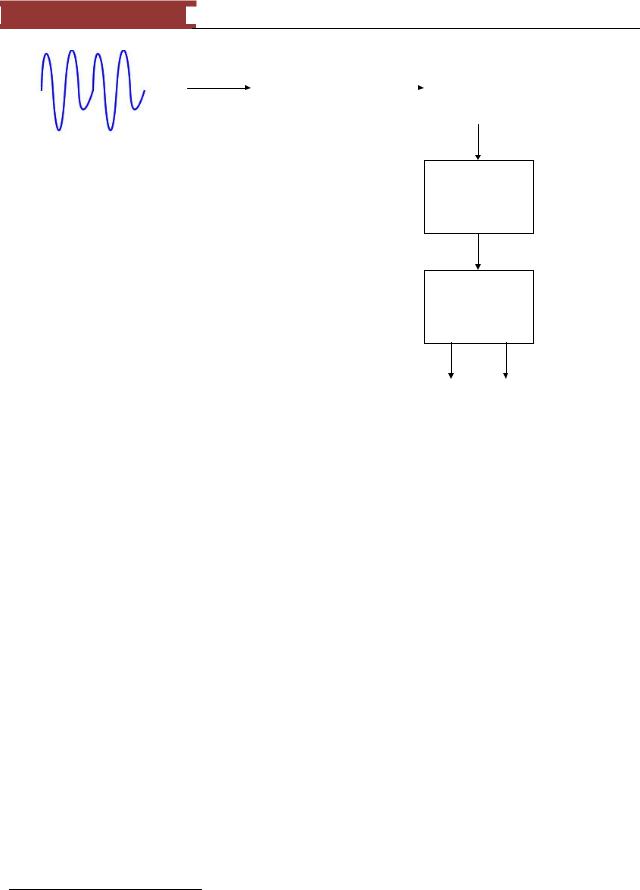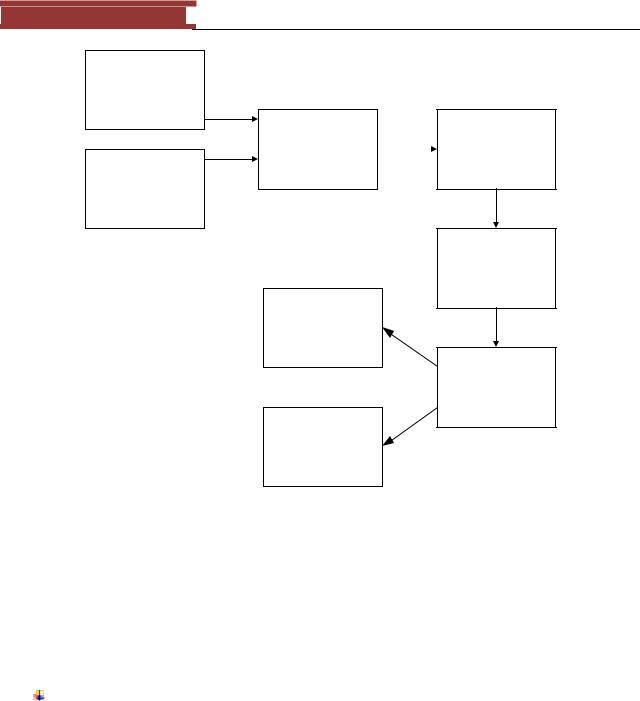
LearningSDL011
.pdf
December 15, 2011 [LEARNING SDL – A BEGINNER’S GUIDE]
[LEARNING SDL – A BEGINNER’S GUIDE]
System Events
Mouse Events
Chapter 5 – How to organize a game
Creating a Game Template
Sample Games
Chapter 6 – Creating Pong
Using SDL_TTF
SDL Audio
In the beginning (80‘s and 90‘s) the only way to make sounds was to use the PC speaker. Here is a little program you can use to test your speaker (it may not work in on all platforms).
Table 16 - PC Beep
#include <cstdlib> #include <iostream>
using namespace std;
int main(int argc, char *argv[])
{
cout << "\a\a\a\a" << endl; cout.flush(); system("PAUSE");
return EXIT_SUCCESS;
}
The program above beeps four times. Each ‗\a‘ corresponds to the ‗alert‘ character which usually makes the PC beep.
131

December 15, 2011 [LEARNING SDL – A BEGINNER’S GUIDE]
[LEARNING SDL – A BEGINNER’S GUIDE]
Having fun with the PC Speaker!
One of my favorite games in the late 80‘s was Maniac Mansion25. It was a graphic adventure game. The most memorable think for me and makes the point that sound matters was the background music used to set the mood as you went thought this creepy house with your friends trying to rescue your girlfriend from the evil mad scientist. It was amazing how the PC speaker was able to play the theme. Today what is even more amazing was how programmers were able to actually make the computer speaker do more than just beep – actual music without a sound card! Impossible?
The PC speaker is normally meant to create a square wave via only 2 levels of
output. But you can actually have it act a DAC (digital to analog convertor) by timing a short pulse, that is, ―going from one output level to the other and then back to the first, it is possible to drive the speaker to various output levels in between the two defined levels. This allows approximate playback of PCM26 audio. This technique is called pulse-width modulation (PWM). The audio produced is poor quality but
recognizable.
There is a open-source C++ software for playing songs on the PC speaker named Smacky (http://smacky.sourceforge.net/).
Games have two types of sounds the first is sounds for events like gun shots, missles blowing or the heavy breathing of monsters. The sounds are short in duration. The second is the audio you here in the background often called background music. Audio music is used to set the atmosphere and tone for the game.
The SDL library SDL_mixer is rather low level and primitive to the other functions we have worked with. The problem stems from trying to make it cross-platform. The lowest common denominator is more primitive with respect to audio (as opposed to video). The first couple of function we will introduce will actually be avoided since it presents problems and issues we don‘t want to really manage when playing sounds or audio…but it helps to know the basics.
Some Audio Basics
25http://en.wikipedia.org/wiki/Maniac_Mansion
26PCM stands for pulse-code modulation a method used to digitally represent sampled analog signals. It is the standard form for digital audio in computers and various Blu-ray, CD and DVD formats.
132

December 15, 2011 [LEARNING SDL – A BEGINNER’S GUIDE]
[LEARNING SDL – A BEGINNER’S GUIDE]
Analog to Digital |
|
|
Sound Card |
Converter (ADC) |
|
|
|
|
|
Device Driver |
|
on Sound Card |
|
|
|
|
|
|
|
|
|
|
|
Sound waves
coming in ...
Operating System
(Windows)
Sound Editing
Program (Audacity)
Memory |
|
Storage Device |
|
(Hard Drive) |
|
|
|
|
|
|
|
Figure 102 - How you record sounds/audio on your computer
Suppose you wanted to record sounds for your game using your computer. You would first get a sound editing program such as Audacity to record27. When you are recording the sound the software is instructing the sound card to capture the input using a special hardware device called an ADC. A simple description for how the ADC works is that it periodically checks the electrical current (or voltage) coming in from the microphone and records the current (or voltage) level and translates it into a discrete number. This number is called a sample. How often (in one second) it samples or checks and creates a number is called the sample rate. That is, the sample rate is the number of times per second the ADC produces a data sample. For example if the ADC is sampling 11,025 samples per second we represent that as
11025Hz. Hz stands for ―Hertz‖. Typical sampling rates are 44,100Hz which gets shortened to 44.1 kHz. The notation stands for ―KiloHertz) and it simply gets computed by dividing the Hz value by 1000. The value 44.1 kHz is special since it represents the sampling rate for a CD audio track.
The typical values used for sampling are 11025Hz, 22050Hz or 44100Hz. The higher the sampling rate of the sound the greater is the accuracy and quality of the sound. Another factor in the quality and depth of the sound is the number of bits used to represent a sample. Typical values are 8 bits and 16 bits. An 8-bit sample can only represent 256 values for the current (or voltage) level of the sound. A 16-bit sample can distinguish between 65.536 values. This provides the ability to add more richness and depth to the sound recordning.
27 I am assuming you have a microphone or some other input device and a sound card.
133

December 15, 2011 [LEARNING SDL – A BEGINNER’S GUIDE]
[LEARNING SDL – A BEGINNER’S GUIDE]
Memory
Sound playback |
|
Operating System |
program |
|
|
|
(Windows) |
|
(Audacity) |
|
|
|
|
Storage Device
(Hard Drive)
Sound Card
Device Driver
Speakers
Digital to Analog Converter (DAC) on Sound Card
Headphones
Figure 103 - Audio Out
When playing the sound or audio from a file on the hard drive or memory the samples are sent out to another hardware device that converts a digital value to analog (DAC) and sends it out to the speakers of headphones, and from there we hear sounds and music.
Using SDL primitive functions
One library that you can use is the SDL_mixer library. The library contains two key structures:
SDL_AudioSpec – stands for audio specification, it contains information about the sound, such as format of the buffer, the number of channels, etc.
typedef struct { |
|
|
int freq; |
// contains the audio frequency (samples/sec) |
|
Uint16 format; |
// the data format |
|
Uint8 |
channels; // number of channels (1 mono, 2 stereo, |
|
|
|
// 4 surround, 6 surround with center and lfe |
Uint8 |
silence; |
// buffer silence value (calculated), avoid |
|
|
// generating noise |
Uint16 samples; |
// buffer size in samples |
|
Uint32 size; |
// buffer size in bytes (calculated) |
|
|
|
134 |

December 15, 2011 [LEARNING SDL – A BEGINNER’S GUIDE]
[LEARNING SDL – A BEGINNER’S GUIDE]
// callback function for filling the audio buffer void (*callback) (void *userdata, Uint8 *stream, int len);
// ptr the user data which is passed to callback
void *userdata; } SDL_AudioSpec;
The common values for samples per second are 11025, 22050, and 44100. The higher the sample rate the higher the quality of sound. The format can be one of the following:
Table 17 - Audio Formats
Constant |
Meaning |
AUDIO_U8 |
Each channel consists of a stream of Uint8s. |
AUDIO_S8 |
Each channel consists of a stream of Sint8s. |
AUDIO_U16LSB |
Each channel consists of a stream of little endian Uint16s |
AUDIO_U16MSB |
Each channel consists of a stream of big endian Uint16s |
AUDIO_U16 |
This is the same as AUDIO_U16LSB |
AUDIO_U16SYS |
Can be AUDIO_U16LSB or AUDIO_U16MSB depends on |
|
platform |
AUDIO_S16LSB |
Each channel consists of a stream of little endian Sint16s |
AUDIO_S16MSB |
Each channel consists of a stream of big endian Sint16s |
AUDIO_16 |
Same as AUDIO_S16LSB |
AUDIO_S16SYS |
Can be AUDIO_S16LSB or AUDIO_S16MSB depends on |
|
platform |
You create a callback function in order to play any audio.
SDL_AudioCVT – stands for audio convert, holds information to covert sound from one format to another
typedef struct { |
|
int needed; |
// set to 1 if conversion is possible |
Uint16 src_format; // audio format of the source Uint16 dest_format; // audio format of the destination double rate_incr; // rate conversion increment
Uint8 *buf; // audio buffer
int len; // length of the original audio buffer in bytes int len_cvt; // length of the converted audio buffer in bytes int len_mult; // buf must be len * len_mult butes in size double len_ratio; // final audio size is len * len_ratio
// pointers to function needed for converions
void (*filters[10]) (struct SDL_AudioCVT *cvt, Uint16 format);
int filter_index; |
// index of current conversion function |
} SDL_AudioCVT; |
|
If you plan on using the SDL_mixer library to play sounds and audio the first function you use to initialize the audio subsystem is SDL_OpenAudio.
135

December 15, 2011 [LEARNING SDL – A BEGINNER’S GUIDE]
[LEARNING SDL – A BEGINNER’S GUIDE]
Function Name: SDL_OpenAudio
Format:
int SDL_OpenAudio(SDL_AudioSpec *desiredAS, SDL_AudioSpec *obtainedAS);
Description:
You fill in the desired valued in the SDL_AudioSpec data structure desiredAS. The function returns 0 is successful and populated obtainedAS with the values obtained. If it fails the value returned is -1. Further if obtainedAS is NULL then the audio data will be as specified in the desiredAS.
SDL Joystick
Chapter 7 – Creating MindSweeper
Chapter 8 – Creating Breakout
Chapter 9 – Creating Tetris
Chapter 10 – SDL Threads and Timers
Chapter 11 – Building a multiplayer online game
SDL_NET
SDL_MIXER
Chapter 12 – Building a Platform Game
Why I love Crisis Mountain!
Why I love Mario!!
136

December 15, 2011 [LEARNING SDL – A BEGINNER’S GUIDE]
[LEARNING SDL – A BEGINNER’S GUIDE]
Chapter 13 – Other libraries and tools to build games
Chapter 14 – What comes next?
Last Chapter
137

December 15, 2011 [LEARNING SDL – A BEGINNER’S GUIDE]
[LEARNING SDL – A BEGINNER’S GUIDE]
Bibliography
LaMothe, Andre. Black Art of 3D Game Programming: Writing Your Own High-Speed 3D Polygon Video Games in C. Corte Madera, CA: The Waite Group, 1995.
Pazera, Ernest. Focus on SDL. Cincinnati, Ohio: Premier Press, 2003.
138

December 15, 2011 [LEARNING SDL – A BEGINNER’S GUIDE]
[LEARNING SDL – A BEGINNER’S GUIDE]
Appendix A: Places to visit on the Web
1.http://www.brainycode.com – This is the author‘s website. As this book develops – versions are placed online for review. I also updated any images or files your may want to use in order to complete the labs and exercises.
2.http://www.libsdl.org – This is the main Simple Directmedia Layer (SDL) web site. You can obtain the latest libraries, sample code and wiki information. I highly recommend it.
3.http://www.sdltutorials.com/ - A greate place for tutorials and information on what is going on . The even have game contests you can try your hand at.
4.http://galaxygameworks.com/index.html - This is a relatively new website created by Sam Lantinga the original developer of SDL. He has many accomplishments at a relatively young age
– lead engineer for Loki Entertainment, author of SDL, and had a lead software engineering role on many Blizzard games (World of Warcraft, StarCraft II, etc). My hero!
5.http://sdl.beuc.net/sdl.wiki/FrontPage - This website is the place to go for SDL documentation and examples. I used to it to obtain details on all SDL functions described in these notes.
6.http://www.gamedev.net/ - A great place for game development discussions and tutorials.
139

December 15, 2011 [LEARNING SDL – A BEGINNER’S GUIDE]
[LEARNING SDL – A BEGINNER’S GUIDE]
Appendix B – Microsoft Visual C++ 2010 Express
140
